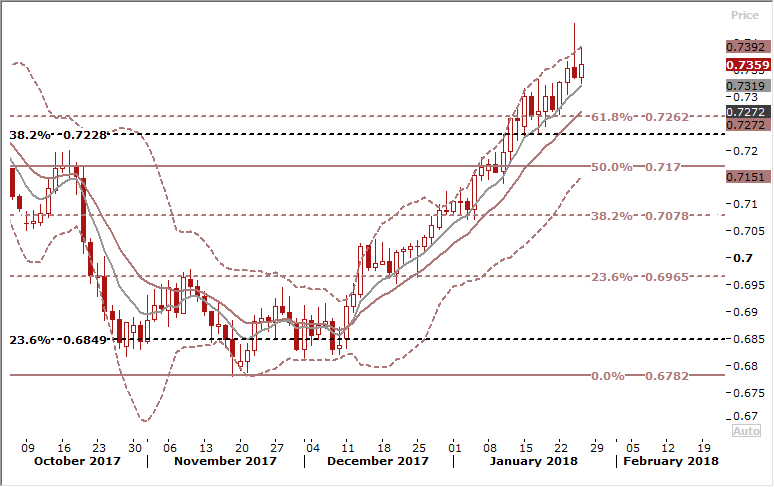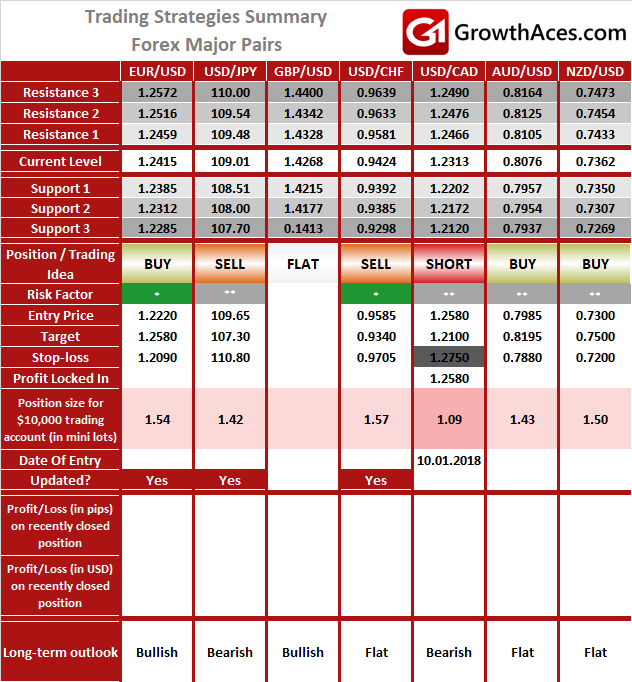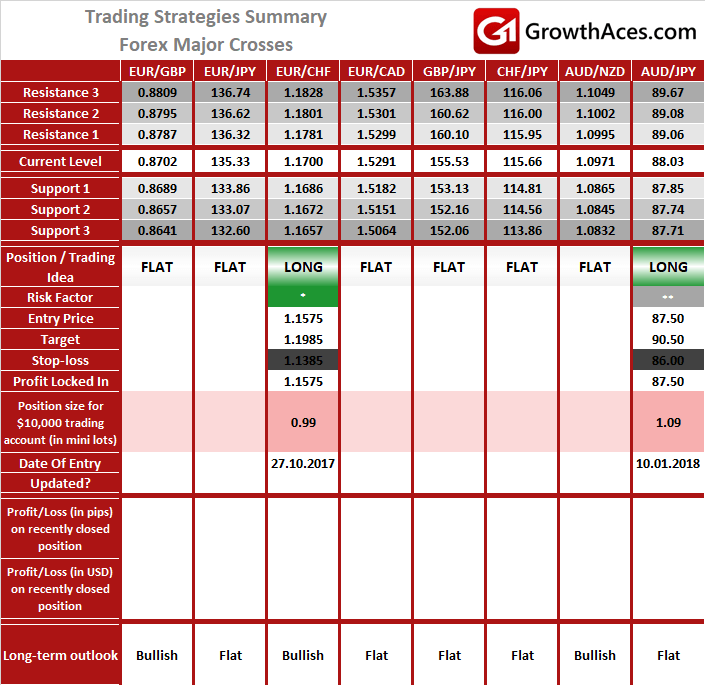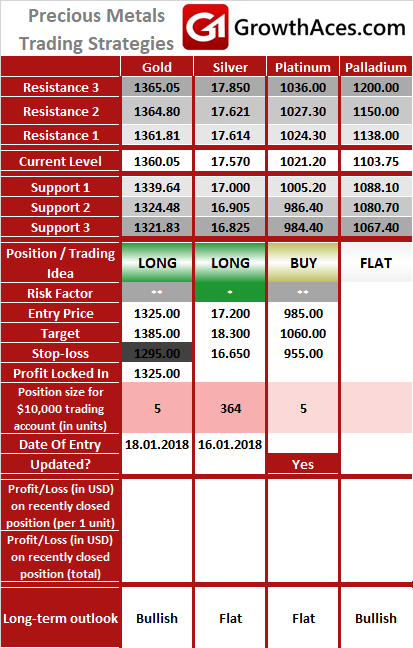EUR/USD: Will ECB attempt to lean against euro strength?
Macroeconomic overview:
-
Today, the ECB is likely to confirm both its monetary policy and the key pillars of its rhetoric. While the account of the December meeting hinted at a possible communication change “early” this year, we think that any revision to the forward guidance will have to wait at least until March. Comments by Vice President Vitor Constâncio support this view. After all, we are just two weeks into the QE tapering to EUR 30bn per month and core inflation remains stuck below 1% with no signs yet of a sustainable upward trend. The main focus is whether the central bank will show concern about recent euro appreciation.
-
What a day it was yesterday in FX market! Apparently, it was not enough that the greenback has come under immense pressure over the past year on account of overvaluation, messy US politics and a re-pricing towards a stronger global growth outside the US. Now its decline is being openly “endorsed” by US Treasury Secretary Steven Mnuchin, who praised the weak dollar for its beneficial effect on the economy’s trade balance. Surely, FX-eyes today will turn to the ECB meeting and Mario Draghi’s press conference to see whether the central bank will attempt to lean against EUR/USD strength.
-
We would push back against these concerns: to be clear, while the EUR/USD ascent to multi-year highs is not something that the ECB is thrilled about, it is not something it should be overly worried about either. First, growth is too strong – both domestically and abroad – for the central bank to revert to its 2015 “obsession with the exchange rate”. Second, despite EUR/USD having risen by more than 5% since the last ECB meeting in December, the trade-weighted EUR has appreciated at a far slower pace, around 1%. This is because the narrative in the FX market is not just about euro-strength but also about dollar-weakness. Which brings us to our last point: it is really very difficult to envisage a meaningful and sustainable turn in the USD anytime soon, especially when US political endorsement of the “weak-dollar” is added to the symphony of other USD-bearish factors.
-
Needless to say that, if Mario Draghi warns again that the volatility in the FX market is a source of uncertainty and requires monitoring, then we would be buyers of any potential EUR/USD retreat. Although these comments (used in September 2017) were associated with the pair declining from 1.20 to 1.1560, this move largely reflected a dollar pullback (that lasted for a couple of months) rather than idiosyncratic euro weakness; and it is very difficult in this environment to imagine a similar USD rebound – though short-term rallies should be expected.
Technical analysis and trading signals:
-
The EUR/USD bias remains on the upside, scope for eventual gains to the 1.2599 major Fibonacci level – 61.8% retrace of the 1.3995-1.0340 (2014-2017 fall). 14-week momentum remains positive, reinforcing the underlying bullish bias.
-
We are looking to buy on dips, which are likely if Draghi warns against the EUR moves at today’s press conference.
NZD/USD rally hampered by New Zealand’s inflation data
Macroeconomic overview:
-
New Zealand's consumer prices rose at a slower-than-expected pace in the fourth quarter of last year, weighed by the falling costs of cars and food and hosing down expectations that the central bank will raise interest rates this year.
-
The consumer price index posted annual growth of 1.6%, edging back from the 2% midpoint of the central bank's target band and below the market expectations of 1.9%
-
The surprise result was unwelcome news for the Reserve Bank of New Zealand, which has kept the official cash rate at a record low of 1.75% since late 2016 in an effort to help consumer price inflation stabilise around the middle of its 1% to 3% target band.
-
The RBNZ is set to meet on February 8 for its first monetary policy decision of the year.
Technical analysis and trading signals:
-
The pair remains above 7-day exponential moving average, which keeps bullish bias intact, but long upper shadow on candlestick chart yesterday suggests that NZD/USD rally is losing its momentum.
-
We placed NZD/USD bid at 0.7300.
TRADING STRATEGIES SUMMARY:
FOREX - MAJOR PAIRS:
FOREX - MAJOR CROSSES:
PRECIOUS METALS:
How to read these tables?
-
Support/Resistance - three closest important support/resistance levels
-
Position/Trading Idea:
BUY/SELL - It means we are looking to open LONG/SHORT position at the Entry Price. If the order is filled we will set the suggested Target and Stop-loss level.
LONG/SHORT - It means we have already taken this position at the Entry Price and expect the rate to go up/down to the Target level. -
Stop-Loss/Profit Locked In - Sometimes we move the stop-loss level above (in case of LONG) or below (in case of SHORT) the Entry price. This means that we have locked in profit on this position.
-
Risk Factor - green "*" means high level of confidence (low level of uncertainty), grey "**" means medium level of confidence, red "***" means low level of confidence (high level of uncertainty)
-
Position Size (forex) - position size suggested for a USD 10,000 trading account in mini lots. You can calculate your position size as follows: (your account size in USD/USD 10,000) * (our position size). You should always round the result down. For example, if the result was 2.671, your position size should be 2 mini lots. This would be a great tool for your risk management!
Position size (precious metals) - position size suggested for a USD 10,000 trading account in units. You can calculate your position size as follows: (your account size in USD/USD 10,000) * (our position size). -
Profit/Loss on recently closed position (forex) - is the amount of pips we have earned/lost on recently closed position. The amount in USD is calculated on the assumption of suggested position size for USD 10,000 trading account.
Profit/Loss on recently closed position (precious metals) - is profit/loss we have earned/lost per unit on recently closed position. The amount in USD is calculated on the assumption of suggested position size for USD 10,000 trading account.
Our research is based on information obtained from or are based upon public information sources. We consider them to be reliable but we assume no liability of their completeness and accuracy. All analyses and opinions found in our reports are the independent judgment of their authors at the time of writing. The opinions are for information purposes only and are neither an offer nor a recommendation to purchase or sell securities. By reading our research you fully agree we are not liable for any decisions you make regarding any information provided in our reports. Investing, trading and speculation in any financial markets may involve high risk of loss. We strongly advise you to contact a certified investment advisor and we encourage you to do your own research before making any investment decision.
Recommended Content
Editors’ Picks
AUD/USD posts gain, yet dive below 0.6500 amid Aussie CPI, ahead of US GDP

The Aussie Dollar finished Wednesday’s session with decent gains of 0.15% against the US Dollar, yet it retreated from weekly highs of 0.6529, which it hit after a hotter-than-expected inflation report. As the Asian session begins, the AUD/USD trades around 0.6495.
USD/JPY finds its highest bids since 1990, approaches 156.00

USD/JPY broke into its highest chart territory since June of 1990 on Wednesday, peaking near 155.40 for the first time in 34 years as the Japanese Yen continues to tumble across the broad FX market.
Gold stays firm amid higher US yields as traders await US GDP data

Gold recovers from recent losses, buoyed by market interest despite a stronger US Dollar and higher US Treasury yields. De-escalation of Middle East tensions contributed to increased market stability, denting the appetite for Gold buying.
Ethereum suffers slight pullback, Hong Kong spot ETH ETFs to begin trading on April 30

Ethereum suffered a brief decline on Wednesday afternoon despite increased accumulation from whales. This follows Ethereum restaking protocol Renzo restaked ETH crashing from its 1:1 peg with ETH and increased activities surrounding spot Ethereum ETFs.
Dow Jones Industrial Average hesitates on Wednesday as markets wait for key US data

The DJIA stumbled on Wednesday, falling from recent highs near 38,550.00 as investors ease off of Tuesday’s risk appetite. The index recovered as US data continues to vex financial markets that remain overwhelmingly focused on rate cuts from the US Fed.




